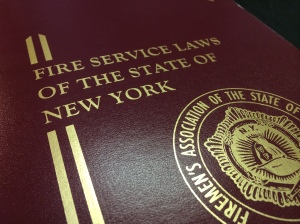 On Saturday, September 26, 2015, I was honored to be invited to participate as one of the panelists at the 2015 Western New York Fire District Officers Legislative Association Workshop. I understand that the event was a “sell-out” with fire district officials from over 11 counties in attendance. There were many topics covered, and I wanted to follow-up with a short post including some additional information and links to relevant information from some of the topics that were covered.
On Saturday, September 26, 2015, I was honored to be invited to participate as one of the panelists at the 2015 Western New York Fire District Officers Legislative Association Workshop. I understand that the event was a “sell-out” with fire district officials from over 11 counties in attendance. There were many topics covered, and I wanted to follow-up with a short post including some additional information and links to relevant information from some of the topics that were covered.
Fundraising. During one of the breaks, I was asked about firefighters participating in fundraising activities in support of other (non-fire) organizations. A word of caution about this. Although the statute governing fundraising, General Municipal Law section 204-a, generally provides that firefighters participating in fundraising activities are covered by the Volunteer Firefighters’ Benefit Law (“VFBL”), not all kinds of fundraising activities are included in this coverage. Section 204-a defines “fund raising activity” as “a method of raising funds to effectuate the lawful purposes of a fire company.” Thus, if the funds are not being raised for “the lawful purposes of a fire company” it is not likely that there would be coverage under the VFBL if a firefighter is injured while participating in such activity.
One of the fundraising activities briefly discussed involved raffles. The New York State Gaming Commission website has a section dedicated to Charitable Gaming–including Raffles. You can find it here. It is critical that both the requirements of the General Municipal Law and the applicable gaming rules are followed.
Firefighters Under 18. There are opinions from the Attorney General’s Office indicating that firefighters may be as young as 16 years old. But, before deciding whether or not to permit firefighters that young, the fire district should consult with counsel about the unique rules applicable to such firefighters, and also to review the risks associated with having firefighters that young on active duty. Fire districts are also authorized by section 204-b of the General Municipal Law to establish youth programs, provided the program complies with the requirements of the statute. Participants in such a youth program are not active firefighters. Unlike active firefighters, youth participants are not eligible for VFBL coverage, and they may not participate in any emergency operation or any hazardous activity.
Blue Lights. The SafeNY website contains a good FAQ page [here] with a good summary of the requirements applicable to the different types of sirens and flashing lights–including the blue lights used by volunteer firefighters. The website also contains links to the relevant statutes, including Section 375(41)(4), which governs the use and operation of the blue lights.
Bonding Credit Card Users. Recent audits by the New York Comptroller have included a recommendation that fire districts and other municipalities bond individuals who are issued credit cards. Here is a copy of a recent audit with this recommendation.
Document Retention Policies. I have been asked by my fire district clients how long it should retain certain documents. Fortunately, the New York State Archives published a document retention and disposition schedule applicable to fire districts and other political subdivisions in New York. The schedule–known as MU-1–may be found here.
Thank you for visiting my blog. I hope you consider subscribing by email, liking my page on Facebook, or following me on Twitter. You may also want to subscribe to our firm’s email newsletter, In Confidence, here. You can subscribe to only the topics you are interested in, and from time to time, I write about developments impacting New York municipalities, including fire districts.
